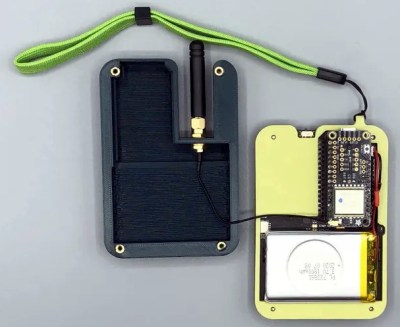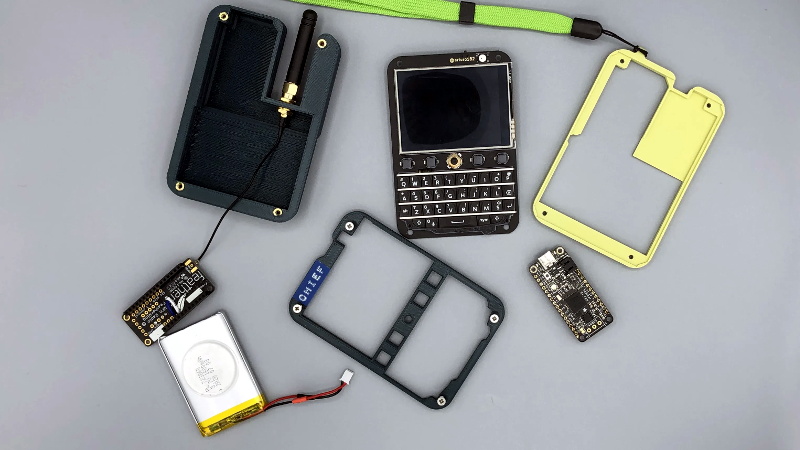While the de facto smartphone design ultimately went in a different direction, there’s no denying the classic BlackBerry layout offered some compelling advantages. It was a gadget primarily designed to send and receive emails and text messages, and it showed. So is it really any wonder [MSG] would build his pocket-sized LoRa messengers in its image?
 Of course, he did have some help. The communicators use the Keyboard FeatherWing by [arturo182], which puts a surplus BlackBerry Q10 keyboard on a custom PCB designed to accept a board from Adafruit’s Feather collection. [MSG] ended up pairing his with a Feather M4 because he wanted to work with CircuitPython, with a 900 MHz LoRa FeatherWing along for the ride. He notes that switching his code over to Arduino-flavored C would allow him to use the Feather M0 that features integrated LoRa; a change that would allow him to make the gadget a bit thinner.
Of course, he did have some help. The communicators use the Keyboard FeatherWing by [arturo182], which puts a surplus BlackBerry Q10 keyboard on a custom PCB designed to accept a board from Adafruit’s Feather collection. [MSG] ended up pairing his with a Feather M4 because he wanted to work with CircuitPython, with a 900 MHz LoRa FeatherWing along for the ride. He notes that switching his code over to Arduino-flavored C would allow him to use the Feather M0 that features integrated LoRa; a change that would allow him to make the gadget a bit thinner.
Inside the 3D printed enclosure, He’s made room for a 3.7 V 1800 mAh pouch battery that should provide plenty of runtime. There’s also an external antenna with a uFL pigtail for connecting to the radio. The case is held together with heat-set inserts, which should make it more than robust enough to handle a few adventures.
[MSG] says slight variations in hardware versions means his STLs might need a little tweaking to fit your components, and warns that his code is basically just a mashup of examples he found online, but he’s still sharing the goods for anyone who wants to reach out and touch someone without all that pesky infrastructure in the way.















While it’s perfectly valid to prioritise the “look like a Blackberry” aesthetic, it seems at odds with the purpose of LoRa (long and range come to mind) to hide the antenna behind all the plastic, display and next to a load of PCB. The blog doesn’t seem to report what performance is achieved but it would be interesting to know if it comes close to what the creator was hoping for.
Now, given that the antenna is on a pigtail, a pull out antenna for transmission and retract for stowage antenna would be a lovely development.
Admitted, I like the aesthetic concept, but subtlety is usually best if you’re going to use something in public. It’s usually best not to induce the general public’s goto fear and retaliation response. Site “walkie-talkie” style radios can readily be found capable of 3km or more or a fairly small budget, s little circuit surgery to commandeer the amplifier and or adjust the frequency, add a couple of s2p shift registers to each side, some rotation magic to keep it in phase, maybe DTMF to binary to speed things up, who knows what could be made, keeping it in the FCC’s good books is probably the tricky bit.
Perhaps have a wifi mesh network, send out a message with a date stamp and a destination, pass the parcel style until the time runs out or the message arrives, granted, encryption would be a must because there would almost always be a man in the middle.
It’s not tricky to keep the FCC happy, get an amateur radio license and use the allocated bands. Hams have been doing long range packet radio for eons.
Data/encrypted transmission is not allowed on PMR band
It’s only illegal if you get caught.
Encrypted to evade decoding is illegal on ham bands, encoded to an open standard is not.
Who cares what the public thinks? If they call the police then it’s on their conscience for calling the police and wasting tax payers money while simultaneously wondering why they’re paying more taxes. But glad you pointed how stupid the general public can be.
Looks great, I’ve always wanted something like this.
Is it correct that LoRa is a gray area since the signal is encrypted so can’t be used without a license?
That’s always been my main barrier to making use of it.
Even if wireless communication things like this aren’t encrypted, it’s still tricky making them complaint for unlicenced use. RX okay, TX, is another story.
Assuming you are talking about the US:
Encryption is fine on the ISM bands. You’re thinking of Amateur radio, FRS, CB, or GMRS frequencies that don’t allow encryption. Cordless phones have encryption and they are on ISM bands. I also have 3 Gotenna Mesh units that run on 900mhz ISM and they use encryption. They are FCC certified devices. WiFi and Bluetooth are ISM bands… also use encryption.
LoRa uses the ISM (Industrial, Scienteific, and Medical) bands, which do not require any license, therefore there is no prohibition on encryption. I don’t know what the power or bandwidth limits are, but yes, you can transmit legally. You just have to accept that it’s a shared band, and those industrial, scientific, and medical users may stomp all over whatever you’re doing with it.
What I’m surprised about is that we don’t see a hack that gives the same capabilities but in an open-source ecosystem. LoRa stuff seems to be unnecessarily expensive.
@Alex Rossie says: “Is it correct that LoRa is a gray area since the signal is encrypted so can’t be used without a license?”
In the U.S. (where I live) as long as you use an unaltered LoRa module that is FCC approved on the proper frequencies and as intended, it is OK if the data is encrypted and you do not need a license.
For U.S. amateur radio operators, using LoRa on the amateur radio bands is a lot more complicated…
If you are a U.S. licensed amateur radio operator and you find a way to put LoRa on the U.S. amateur bands, it might be legal provided the data is not encrypted and you are using amateur bands above 10 meters (above 29.7 MHz). Due to higher than FCC-permitted bandwidth and data/symbol rates I do not believe it is legal to use LoRa on the U.S. amateur bands below the ten meter band (29.7 MHz or lower). Message traffic transmissions on the U.S. amateur radio bands can never be encrypted. Also, in amateur radio there are lots of regulations and accepted practices on modulation, bandwidth, spurious emissions, interference, data and/or symbol rates, etcetera that you must consider. These regulations and practices vary with the band selected and/or the mode of operation.
That said, LoRa is being used today on the amateur radio bands in the U.S. and other countries.[1][2][3][4] I believe this is OK because it is possible to turn encryption off in LoRa. I’m not so sure that is true with the proprietary LoRaWAN gateway though, but LoRaWAN is not needed for point-to-point or contention-based communications, and there are open networking alternatives like AX.25 and RadioHead [5] to name just two. There is scrambling and interleaving in LoRa for bandwidth control/timing-recovery and burst error control, but the PRBS scrambling polynomial and interleave scheme are openly published and all LoRa hardware is the same, so it is not the same as encryption. U.S. regulations require that all operational amateur stations must identify themselves by transmitting their call signs at the end of each transmission or once every ten minutes. Amateur radio LoRa stations typically accomplish this by transmitting ‘beacon’ packets containing the station’s call sign.
As for amateur radio LoRa hardware, in the U.S. commercial LoRa modules intended for use outside the U.S. on the 433 MHz ISM band [6] can be used in the U.S. amateur 70 centimeter (420-450 MHz) band. There are also LoRa products and designs that work on various U.S. amateur bands, some with much higher transmit power compared with a stock commercial 433 MHz LoRa module.[7]
References:
1. LoRaHam wiki
https://github.com/travisgoodspeed/loraham/wiki
2. travisgoodspeed/loraham
https://github.com/travisgoodspeed/loraham
3. LoRaMaDoR
https://epxx.co/artigos/loramador_en.html
4. elvis-epx/LoRaMaDoR
https://github.com/elvis-epx/LoRaMaDoR
5. RadioHead Packet Radio library for embedded microprocessors
http://www.airspayce.com/mikem/arduino/RadioHead/
6. Adafruit Feather M0 RFM96 LoRa Radio – 433MHz – RadioFruit, PRODUCT ID: 3179 $34.95
https://www.adafruit.com/product/3179
7. HamShield: LoRa Edition – 1 Watt – 144/440/915MHz – Version 2 $59.00
https://inductivetwig.com/products/hamshield-lora-edition-high-power
None of your references look like they are authorities on the subject. I said “oh, good, he cited references”. But I was expecting them to be in FCC regulations somewhere. So unless THEY cite FCC regs, they may be just describing common practice, which is not necessarily legal.
I didn’t think there was an issue provided that (1) it is using an ISM band and (2) it is below the specified power limit for that band, otherwise WiFi would be in trouble. LoRa is a very low power system, but the receiver can discriminate very weak signals because of the coding scheme used, and this is what gives it the range.
Considering GoogleFi gives free data only sims to customers, I would carry a second device just for email and texting if it had the old blackberry trackball keyboard. IMHO, they started going downhill with the curve and kept getting worse. But to this day I am not half as productive with email as I was on a blackberry.
I loved the Peek email device. I used it for email and text. I miss the simplicity. In a pinch I could get directions and do basic searches.
Checkout the meshtastastic project https://www.meshtastic.org/
https://disaster.radio another great code for esp32
(PRO DOG)
Looks like the engineers of Megasaki have been busy :)
Interesting, but the form factor doesn’t seem to me that handy for texting; I’d rather go for a old-Nokia like design such as the Pocket Popcorn Computer (https://pocket.popcorncomputer.com) but open and cheaper. That project may be dead as it doesn’t seem they updated the site in some time and all they have is 3D renders, but the idea is good and more suitable for texting.
LoRa could be also tested for voice communications in such small terminals; although it’s inherently a low data rate system (hence the name) it however exceeds the speed needed by Codec2 for example, so voice communications should be doable. Check this 700 bits per second example https://www.rowetel.com/downloads/codec2/hts1a_700c.wav
I am thinking brilliant! why not integrate wifi so if out of range of lora or if speech/codec or richer messaging like images was desired. it could also be used to complete opportunistic store and forward mesh routing like if a use happens to be in contact with another node that happens to have reachability of of lora nodes currently out of reach it can forward the messages to them. That would just be fantastic.
I was wondering if someone could help me convert this from RPi/Python to Arduino?